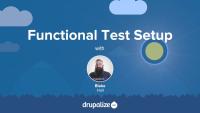Autocomplete provides a brief and quick list of results to the user while typing. While this functionality isn’t available out of the box, it’s easy to add using an additional contributed module, Search API Autocomplete.
In this tutorial, we'll:
- Describe how to add autocomplete functionality to an existing index
By the end of this tutorial you should be able to add an autocomplete feature to the search query text field.
One of the key advantages of custom search is to do more than provide a single, global search box. Filtering allows you to divide results to a subset.
In this tutorial, we'll:
- Describe how to configure filtering through use of a taxonomy field
- Explain the disadvantages of this approach, including how it relies on Views to reduce results rather than Solr
Filtering results allows us to divide up the result set along one or more dimensions. It’s built in to Search API, but often we need a slightly different approach. Drill-down search or faceted searching allows us to constrain (rather than divide) our result set to one or more dimensions. The contributed Facets module provides this functionality.
In this tutorial, we'll:
- Describe how facets constrains results to preconfigured dimensions
- Demonstrate how use of a facet also constrains the possible selections for other facets
- List the steps for installing Facets module
- Describe the field types best used for creating facets
By the end of this tutorial you should be able to explain what facets are and how they work in the context of searching a Drupal site's content.
Creating a facet in Drupal is rather different from using Facets API in Drupal 7. In the new module, we first create a search view, and then configure facets against target fields in the index. Once created, we must configure the facet UI to appear on target pages using the Blocks UI.
In this tutorial, we'll:
- List the steps necessary to create a facet using a non-reference field (i.e. boolean, or text list)
- Explain why facets are displayed using blocks
- Describe the various facet display modes and uses for each
By the end of this tutorial you should be able to add a facet based on a text list field and allow users to filter search results using the values in the list field.
A powerful facet combination is to create a search Facet on a taxonomy field. This brings several advantages to how your search can be configured and displayed.
In this tutorial, we'll:
- Describe the additional complexities for using a reference field for a facet
- Show how to use taxonomy weights to control facet option order
By the end of this tutorial you should be able to add a facet that allows users to filter search result based on taxonomy terms.
In order to run tests, your Drupal site needs additional development requirements installed using Composer.
By default, when you download Drupal as a zip file or tarball, these packages will not be installed, since they're used for development purposes.
In this tutorial, we'll walk through the steps to make sure we've got Composer available. Next we'll install the dependencies. Then we'll talk about why you shouldn't have development dependencies available on your production site. Thankfully, Composer can help make this easy to manage.
Simpletest has been removed from Drupal 9. If you're preparing to upgrade your site to the latest version of Drupal and you have Simpletests in your codebase that extend WebTestBase you'll need to update them to use PHPUnit's BrowserTestBase class instead. This will ensure your tests don't depend on a deprecated testing framework. By the end of this tutorial, you should be able to convert WebTestBase-based tests to use PHPUnit's BrowserTestBase class instead.
In this tutorial, we will look at the various types of tests and testing frameworks included in Drupal core. We'll also provide an overview of how the different frameworks operate and the types of situations where each of the different frameworks is useful.
Previously, in Implement a Functional Test, we learned how to tell BrowserTestBase to use the Standard installation profile in order to get our test passing, letting the Standard profile implicitly provide our dependencies. We mentioned that doing so probably wasn't the best decision and that we should explicitly declare those dependencies instead.
In this tutorial, we'll walk through how to explicitly declare our test's dependencies. When in doubt, it's generally considered a best practice to be as explicit about the dependencies of our tests as possible. By the end of this tutorial, you should be able to:
- Understand why we want to explicitly declare our dependencies.
- Determine what the dependencies really are and make a list of them.
- Implement each dependency in our list.
- Emerge with a thorough passing test.
In this tutorial, we'll walk through the basics of how to implement a functional test by extending Drupal's BrowserTestBase class. We'll assume you've already determined that you need to write a functional test and that you've Set up a Functional Test.
In this tutorial, we'll:
- Determine the specifications of the test.
- Walk through the behavior we want to test.
- Document our test in the test class.
- Implement the testing steps.
- Decide how to deal with dependencies (for now). (We'll go into details about handling test dependencies in Implement Drupal Functional Test Dependencies.)
Let's write somewhat strict unit tests in a Drupal module. By the end of this tutorial, you will be able to:
- Understand what makes a unit test different from other types of tests.
- Determine the specifications of a unit test.
- Use mocking to isolate units under test, and to force code flow to achieve high coverage.
We'll start out with a brief introduction to unit tests. Then we'll look at a contrived example of a Drupal controller class for illustration purposes. Next, we'll test two units of this controller class, each requiring different mock styles.
In this gentle introduction to testing, we'll walk through what testing is and why it's important to your project. Then we'll define some terms you'll be likely to see while working with tests so that we're all on the same page. After reading through this tutorial you'll understand enough of the basic vocabulary to get started running (and eventually writing) tests for your Drupal site.
In order for Drupal to be able to locate and run the tests you create, the files need to be put in the correct place. In this tutorial, we'll take a look at the different types of test frameworks that are included along with core. We'll also see how Drupal expects our test files to be organized so that the test runners can find them.
When running tests with PHPUnit we need to specify a phpunit.xml file that contains the configuration that we want to use. Often times (and in much of the existing documentation) the recommendation is to copy the core/phpunit.xml.dist file to core/phpunit.xml and make your changes there. And this works fine, until something like a composer install or composer update ends up deleting your modified file. Instead, you should copy the file to a different location in your project and commit it to your version control repository.
In this tutorial we'll:
- Learn how to move, and modify, the phpunit.xml.dist file provided by Drupal core
- Understand the benefits of doing so
- Demonstrate how to run
phpunitwith an alternative configuration file
By the end of this tutorial you should be able to commit your phpunit.xml configuration file to your project's Git repository and ensure it doesn't get accidentally deleted.
In this tutorial, we'll run tests in several different ways using the PHPUnit tools available in Drupal. We'll learn about various environment variables you'll need to supply to the test runner depending on which type of test you're running. And we'll learn various ways to get reports on the test results. By the end of this tutorial, you should understand how to run Drupal tests using PHPUnit.
In this tutorial, we'll walk through the process of setting up a functional test. Then, we'll learn how to run it using two different test runners. This setup process allows us to be sure we're not getting false positives from the test runners. We'll be working on a functional test, but these techniques apply with minimum modification to all the Drupal PHPUnit-based tests.
By the end of this tutorial, you should be able to set up and run functional tests in Drupal using two different test runners.
This tutorial will clarify some basic ideas about software testing. We'll give some strategies for testing and illustrate types of tests and when and why you'd use them. This document is written with Drupal in mind, but the concepts apply for other development environments you'll encounter as well. The tools will be different, but the ideas apply universally. By the end of this tutorial, you should understand what testing is for and how different types of tests support different purposes and outcomes.
In order to run functional tests that require JavaScript be executed for the feature to work, the tests need to be run in a browser that supports JavaScript. This is accomplished by using the WebDriver API in combination with an application like ChromeDriver or Selenium, which can remotely control a browser.
The exact setup for running functional tests is dependent on your development environment. We'll walk through a couple of common examples including using Docker (via DDEV) and stand-alone applications.
In this tutorial we'll:
- Learn how to install and run ChromeDriver and other necessary tools either in a Docker environment, or locally.
- Configure the relevant PHPUnit environment variables so they contain values appropriate for our specific environment.
- Execute Drupal's functional JavaScript tests via the
phpunitcommand.
By the end of this tutorial you should be able to install the applications required to run functional JavaScript tests in a browser, and know how to configure PHPUnit to make use of them.
Every theme can contain an optional THEMENAME.theme file. This file contains additional business logic written in PHP and is primarily used for manipulation of the variables available for a template file, and suggesting alternative candidate template file names. Themes can also use this file to implement some, but not all, of the hooks invoked by Drupal modules.
In this tutorial we'll learn:
- The use case for THEMENAME.theme files, and where to find them
- The different types of functions and hooks you can implement in a THEMENAME.theme file
By the end of this tutorial you should be able to know how to start adding PHP logic to your custom theme.
Themes and modules can alter the list of theme hook suggestions in order to add new ones, remove existing ones, or reorder the list. This powerful feature allows for the definition of custom logic in your application that can tell Drupal to use different templates based on your own unique needs. You might for example; use a different page template for authenticated users, or a custom block template for someone's birthday.
In this tutorial we'll cover:
- Adding new theme hook suggestions from a theme using
hook_theme_suggestions_HOOK_alter() - Altering the list of theme hook suggestions
- Removing theme hook suggestions
- Reordering the list of theme hook suggestions


